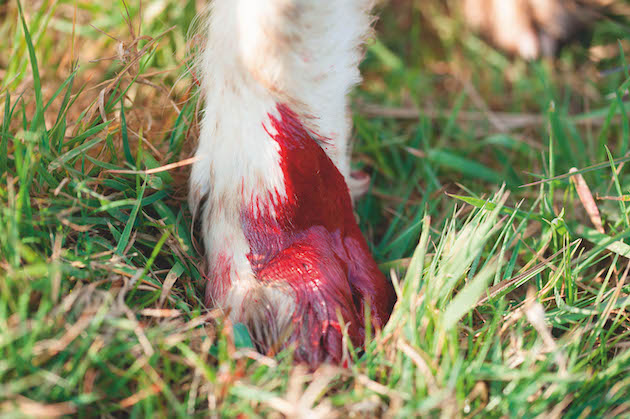Win CENS ProFlex DX5 earplugs worth £1,149 – enter here
How to bathe a dog’s wound
 2BHCMKC Bleeding dog paw
2BHCMKC Bleeding dog paw
A reader recently asked me: “Should I bathe a dog’s wound myself? If so, what should I use? (If your dog has swallowed something harmful, here’s how to make a dog vomit.)
Bathe a dog’s wound
The purpose of bathing a wound is to clean the surrounding skin and hair, remove any debris and avoid contamination. It will generally do no harm if you are gentle and don’t use anything that is likely to delay healing.
It is probably best to use warm salt water. Ideally, you would use a sterile saline solution, but few people have it on hand. Mix two teaspoons of sea salt in a cup of warm tap water and mix until it dissolves.
Stop any bleeding by applying firm, clean finger pressure on the wound or press a clean gauze pad over it, then pour or syringe the salt solution over the wound. If it’s a cut paw that you are treating, hold the foot in a basin or bucket of salt solution for three to five minutes.
After bathing, gently pat the wound dry using either a clean gauze pad or a clean, lint-free cloth or paper towel. Don’t scrub or rub the wound because that might cause further injury.
Unless the wound is grossly contaminated, avoid using an antiseptic and then only use a medical antiseptic, either dilute povidone-iodine or chlorhexidine.
Most household disinfectants and antiseptics cause some degree of tissue damage and should not be used to bathe wounds. Don’t use antiseptic sprays. Dogs normally dislike the sound and usually attempt to lick off the spray. (You might also like to read how to treat paw injuries in the field.)
Related Articles
Get the latest news delivered direct to your door
Subscribe to Shooting Times & Country
Discover the ultimate companion for field sports enthusiasts with Shooting Times & Country Magazine, the UK’s leading weekly publication that has been at the forefront of shooting culture since 1882. Subscribers gain access to expert tips, comprehensive gear reviews, seasonal advice and a vibrant community of like-minded shooters.
Save on shop price when you subscribe with weekly issues featuring in-depth articles on gundog training, exclusive member offers and access to the digital back issue library. A Shooting Times & Country subscription is more than a magazine, don’t just read about the countryside; immerse yourself in its most authoritative and engaging publication.







